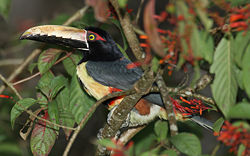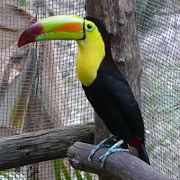Toucan
| Toucan | ||||||||||
|---|---|---|---|---|---|---|---|---|---|---|
 Collared Aracari (Pteroglossus torquatus)
|
||||||||||
| Scientific classification | ||||||||||
|
||||||||||
| Genera | ||||||||||
|
Andigena |
Toucans are a family, Ramphastidae, of near-passerine birds from the neotropics (i.e. Southern Mexico, Central, South American, and Caribbean region). The family is most closely related to the American barbets. They are brightly marked and have large, colorful bills. The family includes five genera and about forty different species. The name of this bird group is derived from Tupi tucana, via French.
Contents |
Morphology
Toucans range in size from the Lettered Aracari (Pteroglossus inscriptus), at 130 g (4.6 oz) and 29 cm (11.5 inches), to the Toco Toucan (Ramphastos toco), at 680 g (1.5 lb) and 63 cm (29 inches). Their bodies are short (of comparable size to a crow's) and compact. The tail is rounded and varies in length, from half the length to the whole length of the body. The neck is short and thick. The wings are small, as they are forest-dwelling birds who only need to travel short distances, and are often of about the same span as the bill-tip-to-tail-tip measurements of the bird.
The legs of a toucan are strong and rather short. Their toes are arranged in pairs with the first and fourth toes turned backward. The majority of toucans do not show any sexual dimorphism in their coloration, the genus Selenidera being the most notable exception to this rule (hence their common name, "dichromatic toucanets"). However, the bills of female toucans are usually shorter, deeper and sometimes straighter, giving more of a "blocky" impression compared to male bills. The feathers in the genus containing the largest toucans are generally black, with touches of white, yellow, and scarlet. The underparts of the araçaris (smaller toucans) are yellow, crossed by one or more black or red bands. The toucanets have mostly green plumage with blue markings.

The colorful, giant bill, which in some large species measure more than half the length of the body, is the hallmark of toucans. Despite its size it is very light, being composed of bone struts with little solid material between them. The bill has forward-facing serrations resembling teeth, which historically led naturalists to believe that toucans captured fish and were primarily carnivorous, but today we know that they eat mostly fruit. Why the bill is so large and brightly colored is still debated and may be complex. As there is no sexual dimorphism in coloration it is unlikely to be a sexual signal; It does aid in their feeding behavior (as they sit in one spot and reach for all fruit in range, thereby reducing energy expenditure). It has also been theorised that the bill may intimidate smaller birds, so that the toucan may plunder nests undisturbed (see Behaviour). Also, the beak allows the bird to reach deep into treeholes to access food unavailable to other birds, and also to depredate suspended nests built by smaller birds.
A toucan's tongue is long (up to 14-15 cm, or 6 inches), narrow, grey, and singularly frayed on each side, adding to its sensitivity as an organ of taste.
A structural complex probably unique to toucans involves the modification of several tail vertebrae. The rear three vertebrae are fused and attached to the spine by a ball-and-socket joint. Because of this, toucans may snap their tail forwards until it touches the head.[1] This is the posture in which they sleep, often appearing simply as a ball of feathers, with the tip of the tail sticking out over the head.
Behavior

Toucans are primarily frugivorous (fruit eating), but are opportunistically omnivorous and will take prey such as insects and small lizards.[2] Captive toucans have been reported to actively hunt insects in their cages, and it is possible to keep toucans on an insect-only diet. They also plunder nests of smaller birds, taking eggs and nestlings.[3] This probably provides a crucial addition of protein to their diet. However, in their range, toucans are the dominant frugivores, and as such play an extremely important ecological role as vectors for seed dispersal of fruiting trees.[4]
Toucans are arboreal and typically lay 2–4 white eggs in their nests. They make their nests in already-existing treeholes like natural cavities and holes excavated by other animals such as woodpeckers - the toucan bill has very limited use as an excavation tool. When the eggs hatch, the young emerge completely naked, without any down. Toucans are resident breeders and do not migrate. Toucans are usually found in pairs or small flocks. They sometimes fence with their bills and wrestle, which scientists hypothesize they do to establish dominance hierarchies.
Systematic list
- Genus Aulacorhynchus - green toucanets (6-13 species, depending on taxonomy)
- Genus Selenidera - dichromatic toucanets (6 species)
- Genus Andigena - mountain toucans (4 species)
- Genus Pteroglossus - araçaris (14 species, incl. Saffron Toucanet)
- Genus Ramphastos - typical toucans (about 8 species)
Toucans in Popular Culture
- Toucan Sam, mascot for Kellogg's Froot Loops cereal
- The Guinness beer toucan
- In the UK, street crossings for both cyclists and pedestrians are called toucan crossings.
References
- ↑ Reynolds, J. (2002) "Book Review: Handbook of the Birds of the World, Vol. 7. Jacamars to Woodpeckers Edited by Josep del Hoyo, Andrew Elliott and Jordi Sargatal. Lynx Edicions, Barcelona, 2002. ISBN 84-87334-377. 613 pages." Biological Conservation 111 (2): 280-281 [1]
- ↑ Remsen, J.V. Remsen, Jr.; Hyde M.A. & A. Chapman. (1993) "The Diets of Neotropical Trogons, Motmots, Barbets and Toucans" The Condor 95 (1): 178-192
- ↑ Robinson, S.K. (1985) "Coloniality in the Yellow-Rumped Cacique as a Defense against Nest Predators" Auk 10 (3): 506-519
- ↑ Pizo, M.A.; Donatti, C.I.; Guedes, N.M.R. & M. Galetti (2008) "Conservation puzzle: Endangered hyacinth macaw depends on its nest predator for reproduction" Biological Conservation 141 (3): 792-796 doi:10.1016/j.biocon.2007.12.023
External links
- Extensive Gallery on Toucans
- List of Toucans
- Gallery of Toucans
- Toucan videos on the Internet Bird Collection